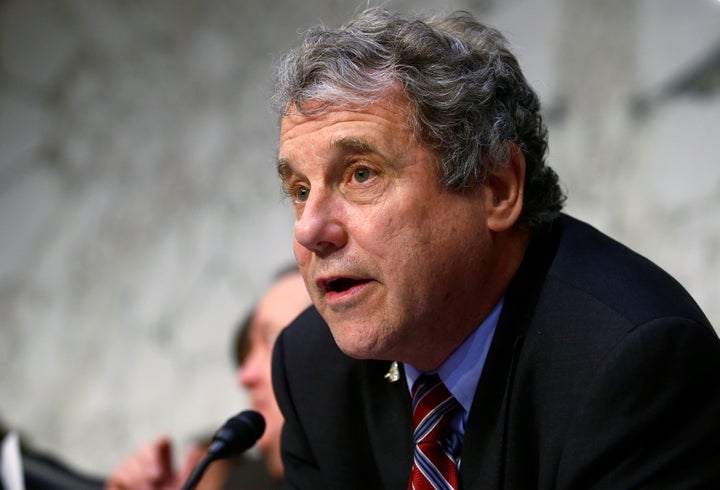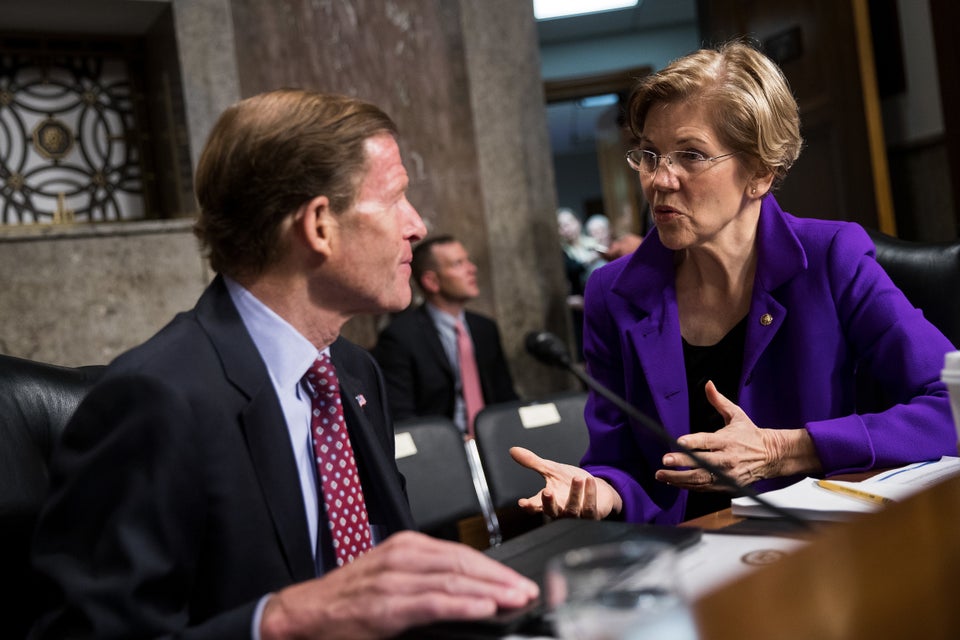
COLUMBUS, Ohio ― Mary Sweet had never volunteered in politics before. And after decades as a solid Republican voter, the retired teacher certainly never expected her door-knocking debut would be for a Democrat.
But on July 28 ― a Saturday ― she stood in the small storefront that houses Democrat Danny O’Connor’s congressional campaign headquarters, eagerly awaiting canvassing instructions.
For Sweet, a Mitt Romney voter in the 2012 presidential race who left the top of her ballot blank in 2016, Donald Trump’s election was a life-changing event. She never thought someone whose personality she found so offensive could win the White House. And the hardline immigration and health care policies that Trump has implemented since the election have only strengthened her commitment to fight back.
O’Connor’s “just gotta win” in Tuesday’s special election for Ohio’s vacant 12th Congressional District seat, Sweet told HuffPost. “He could be Daffy Duck and I would be voting for him.”
Not every Republican backing O’Connor has undergone as stark of a transformation as Sweet, who now supports Medicare for all and jokes about flirting with “socialism.”
But to win in what is likely to be a low turnout election in the traditionally solid-GOP district, Democrats don’t need a tectonic shift. Sky-high enthusiasm among their base and the attrition of just enough moderate Republicans and independents could prove more than enough to carry O’Connor over the finish line against GOP state Sen. Troy Balderson.
“[Danny O'Connor] could be Daffy Duck and I would be voting for him.”
- Mary Sweet, voter, Ohio's 12th Congressional District
O’Connor’s strong chance at victory in Ohio points to a broader Democratic comeback throughout the Midwest this cycle. The Democratic benches in Ohio, Michigan and Wisconsin were decimated by back-to-back Republican waves in 2010 and 2014, and Trump seemingly completed GOP dominance within the region in 2016 by flipping thousands of voters who had previously supported President Barack Obama.
But in 2018, Democrats are putting multiple GOP-held congressional seats, gerrymandered for Republican control, in play in each state. Democratic incumbents are heavily favored to retain Senate seats in states that formed the party’s so-called blue wall ― in Ohio, Michigan, Wisconsin and Minnesota (where two Senate seats are on November’s ballot). Democrats also have a strong chance to win the governorship in each state.
“We own the government now so there are good things with that, like the economy, but it’s also easier to paint Republicans with a broader brush,” said Mark Harris, a Pittsburgh-based GOP consultant who frequently advises Republican candidates in the Midwest.
Asked if Trump was proving a liability in these races, Harris paused, then said, “It’s a challenge.”
In interviews throughout Ohio and the broader Midwest this summer, Democrats said they were seeing unprecedented levels of political enthusiasm among their supporters. Suburbs that include voters who backed Hillary Clinton after supporting Mitt Romney in 2012 appear to be in the midst of a more dramatic political transformation. For instance, the suburbs of Columbus, Detroit and Madison, Wisconsin, are expected to go heavily for Democrats in November. And Democrats are clawing back territory in rural areas that went heavily for Trump in 2016.
A series of NBC News/Marist polls released late in July confirmed what Democrats are seeing on the ground ― even if officials in both parties say they believe the surveys overstated the Democratic advantage. In Michigan, Wisconsin and Minnesota, Trump’s approval rating stood below 40 percent.
Signs of the Democratic resurgence stretch far beyond the tier of moderate suburban districts that the party has already marked as offering ripe pickup opportunities. Democrats in Midwestern states are also forcing the GOP to compete in districts where Trump won by astronomical margins.
In Ohio, that includes LGBT rights activist Rick Neal’s challenge to veteran Rep. Steve Stivers ― the head of the National Republican Congressional Committee ― in the 15th Congressional District, and former Navy pilot Ken Harbaugh’s run against GOP Rep. Bob Gibbs in the 7th.
With help from a political action committee set up by Rep. Seth Moulton (D-Mass.), Harbaugh raised nearly $1.7 million as of the end of June ― more than the twice Gibbs’ haul. Voters in the largely rural 7th district opted for Trump over Clinton by more than 29 percentage points. But Harbaugh, who led a veteran-driven natural disaster relief group, takes heart in eastern Ohio’s idiosyncratic political tendencies: independents outnumber registered Republicans in the district.
He is trying to upend conventional wisdom by barnstorming the most conservative parts of the district (including Ohio’s Amish country), maintaining a laser-like focus on health care and embracing rural culture.
In his quest to demonstrate the latter, Harbaugh has occasionally gone to dangerous lengths. He participated in the Knox County fair’s “Rough Truck” contest, on July 26, driving over big jumps in a beat-up pickup truck with “Ken Harbaugh 4 Congress” spray-painted on it. The stunt, which Harbaugh’s campaign captured on camera, gave him free advertising to a crowd of thousands of onlookers.
During the ride, Harbaugh’s head slammed against the steering wheel, breaking his nose. He emerged from the nearly destroyed truck with blood running down his face.
Three days later, on a Sunday, Harbaugh, whose nose remained black and blue, was trying his hand at the less hazardous outreach of door-knocking in Ashland, a college town encircled by corn fields.
“For decades, Democrats have been drifting away from the hard, hard work of field [organizing]. We have to shoulder the burden of getting out there,” Harbaugh said.
The response from Heather Sullivan, a secretary and infrequent, albeit solidly partisan Democratic voter who answered the door, seemed to affirm his approach.
Sullivan voted for Sen. Bernie Sanders (I-Vt.) in the 2016 Democratic presidential primary, and Clinton in the general election. But she did not know her member of Congress’ name and admitted that she did not vote in the 2014 midterm elections.
Sullivan said she was planning to vote for Harbaugh this year because she was fired up about Trump. And it clearly helped to meet the Democratic candidate in person.
“I’ve never really looked into Congress people. I’ve never had one come to my door,” she said.
“I’m feeling now, only in the last month or so, a level of excitement in Michigan that approaches, if not parallels, what we had for Obama.”
- Jimmy Womack, former Michigan state representative
In Wisconsin, Democratic outside groups have been consistently surprised by the strength of Democratic Sen. Tammy Baldwin, who in her re-election bid has led by double-digit margins in many internal polls. Surveys show the map for Baldwin looking like the map that gave liberal Milwaukee County Circuit Judge Rebecca Dallet a win in a Supreme Court election in April, picking up several counties along the Mississippi River that Trump had previously won.
Democrats nonetheless remain worried about Wisconsin’s Senate contest. While neither GOP nor Democratic Senate leadership is focused on the state ― neither party’s major super PAC has reserved any advertising airtime there ― the powerful Koch Network of conservative donors is prepared to invest heavily in the race regardless of whether state Sen. Leah Vukmir or businessman or Marine veteran Kevin Nicholson wins the Aug. 14 Republican primary. And they bitterly remember Democrat Russ Feingold’s large leads in the polls during the summer of 2016 before GOP Sen. Ron Johnson’s blistering comeback late in the election cycle.
Still, the so-called Democratic blue wall ― which was supposed to protect them from a Trump victory in 2016 ― also seems to be holding at the Senate level in Ohio, Michigan and Minnesota. As is the case in Wisconsin, neither party’s outside groups have reserved ad airtime in any of those states. Past Senate races in Ohio and Wisconsin have seen tens of millions in outside spending.

The gubernatorial races are more of a mixed bag. Former GOP Gov. Tim Pawlenty is making a comeback bid in Minnesota, while Democrats face stiff fights in denying Wisconsin Gov. Scott Walker a third term and in lifting Ohio’s Richard Cordray over Republican Mike DeWine.
The most interesting gubernatorial race may be in Michigan, where both parties’ nominations for an open seat will be decided in Tuesday primaries. The Koch Network has targeted the contest, and both parties expect an expensive showdown.
On the GOP side, Trump-backed Attorney General Bill Schuette is hoping to brush off a series of scandals and triumph over Lt. Gov. Brian Calley. On the Democratic side, former state Sen. Gretchen Whitmer is facing an energetic challenge from progressive Abdul El-Sayed. Some Republicans in the state are hoping for an El-Sayed upset on Tuesday, believing his embrace of single-payer health care and other progressive priorities will make him easier to beat in November.
The Democrat who clinches the nomination is likely to benefit from competitive House races. National Democrats are prioritizing races in the state’s 8th and 11th districts, suburban seats Trump carried by single-digit margins.
In Michigan’s 8th, which includes part of Lansing, its suburbs and some Detroit exurbs, the Democratic Congressional Campaign Committee has already endorsed Elissa Slotkin, a shoo-in for the party nomination. Slotkin, a former CIA officer and Pentagon official backed by Moulton’s PAC, has already raised over $3 million ― about $800,000 more than GOP Rep. Mike Bishop.
And in Michigan’s 11th, an arc of well-off suburbs outside of Detroit, Democrats believe they have an embarrassment of riches with five viable candidates competing to flip an open seat. Suneel Gupta, the top fundraiser, touts his record of entrepreneurship, including the development of an app that became the official technology partner of Michelle Obama’s public health initiative.
Haley Stevens, another frontrunner in the race, highlights her experience as chief of staff in the Obama administration’s rescue of the auto industry. It’s a significant credential in a district that is home to Chrysler’s national headquarters. She also picked up the last-minute endorsement of Hillary Clinton, who recorded a robo-call on her behalf.
“I’m feeling now, only in the last month or so, a level of excitement in Michigan that approaches, if not parallels, what we had for Obama,” said Jimmy Womack, a former Democratic state representative.
“People need a reason to vote,” added Womack, a Detroit-based physician and pastor. “Right now, because of all that’s going on in America people are getting excited, they’re recognizing the need to come out and vote.”
Likewise, Ohio Democrats in tougher races this cycle stand to benefit from the strength of an incumbent Democrat who most poll watchers think will win re-election without much of a fight: Sen. Sherrod Brown. As of the end of June, Brown held a 15-point lead over Renacci in an average of public polls.
Campaign officials for the Republican nominee, Jim Renacci, insist the race remains competitive. They noted Republicans still out-voted Democrats by a 200,000-vote margin in Ohio’s May primary, even after Democratic turnout jumped 67 percent compared to 2014.
And they are already trying to downplay the implications of a potential Republican loss in Ohio’s 12th Congressional District. “I don’t think you can take any special election and use it as a bellwether for November,” Renacci spokeswoman Leslie Shedd said in a phone interview.
Ted Strickland, Ohio’s last Democratic governor and a 2016 Senate candidate, knows a thing or two about races that are not competitive ― he got overwhelmed in that latter race.
While he said Brown would fight for every last vote, he was confident that the contest has already run away from the GOP. “I think that race is over, quite frankly,” Strickland said.
